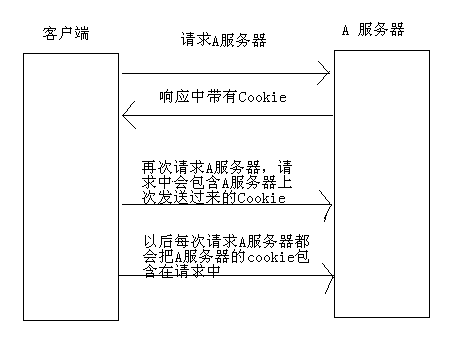【SpringBoot16】SpringBoot中使用Cookie实现记住登录
每次登录都要输入密码,会很麻烦,实现一个记住登录状态的功能,于是便使用 Cookie 实现该功能。
一、Cookie 简介
Cookie,一种储存在用户本地终端上的数据,有时也用其复数形式 Cookies。类型为“小型文本文件”,是某些网站为了辨别用户身份,进行 Session 跟踪而储存在用户本地终端上的数据(通常经过加密),由用户客户端计算机暂时或永久保存的信息。
其实 Cookie 就是一个键和一个值构成的,随着服务器端的响应发送给客户端浏览器。然后客户端浏览器会把 Cookie 保存起来,当下一次再访问服务器时把 Cookie 再发送给服务器。
1、Cookie 是 HTTP 协议的规范之一,它是服务器和客户端之间传输的小数据
2、首先由服务器通过响应头把 Cookie 传输给客户端,客户端会将 Cookie 保存起来
3、当客户端再次请求同一服务器时,客户端会在请求头中添加该服务器保存的 Cookie,发送给服务器
4、Cookie 就是服务器保存在客户端的数据
5、Cookie 就是一个键值对
二、Cookie 使用
1、创建 Cookie
// Cookie 为键值对数据格式
Cookie cookie_username = new Cookie("cookie_username", username);
2、设置 Cookie 持久时间
// 即:过期时间,单位是:秒(s)
cookie_username.setMaxAge(30 * 24 * 60 * 60);
3、设置 Cookie 共享路径
// 表示当前项目下都携带这个cookie
cookie_username.setPath(request.getContextPath());
4、向客户端发送 Cookie
// 使用 HttpServletResponse 对象向客户端发送 Cookie
response.addCookie(cookie_username);
5、销毁 Cookie
// 根据 key 将 value 置空
Cookie cookie_username = new Cookie("cookie_username", "");
// 设置持久时间为0
cookie_username.setMaxAge(0);
// 设置共享路径
cookie_username.setPath(request.getContextPath());
// 向客户端发送 Cookie
response.addCookie(cookie_username);
三、进入正题
上面我们已经了解了 Cookie 是什么,并且知道了 Cookie 的创建以及销毁的方法,下面,我们就使用 Cookie 实现记住登录状态的功能,整个项目基于 SpringBoot 实现
1、注册拦截器
/**
* 注册拦截器
*/
@Configuration
public class WebConfigurer implements WebMvcConfigurer {@Autowiredprivate LoginInterceptor loginHandlerInterceptor;@Overridepublic void addInterceptors(InterceptorRegistry registry) {InterceptorRegistration ir = registry.addInterceptor(loginHandlerInterceptor);// 拦截路径ir.addPathPatterns("/*");// 不拦截路径List irs = new ArrayList();irs.add("/api/*");irs.add("/wechat/*");irs.add("/oauth");ir.excludePathPatterns(irs);}
}
我们拦截了所有的请求路径,放开了 api、wechat 等请求路径
这里可能会有一个疑问,为什么不放开请求登录界面的 api 请求路径呢,原因是我们拦截登录请求,当我们请求登录界面时,我们已经登录过,那么我们就无需进入登录界面,直接到主界面
我们使用了自定义的一个登录拦截:LoginInterceptor,在第二步我们会详细讲解其中的实现原理
2、登录拦截
/**
* 未登录拦截器
*/
@Component
public class LoginInterceptor implements HandlerInterceptor {@Autowiredprivate LoginDao dao;@Overridepublic boolean preHandle(HttpServletRequest request, HttpServletResponse response, Object handler) throws Exception {// 获得cookieCookie[] cookies = request.getCookies();// 没有cookie信息,则重定向到登录界面if (null == cookies) {response.sendRedirect(request.getContextPath() + "/login");return false;}// 定义cookie_username,用户的一些登录信息,例如:用户名,密码等String cookie_username = null;// 获取cookie里面的一些用户信息for (Cookie item : cookies) {if ("cookie_username".equals(item.getName())) {cookie_username = item.getValue();break;}}// 如果cookie里面没有包含用户的一些登录信息,则重定向到登录界面if (StringUtils.isEmpty(cookie_username)) {response.sendRedirect(request.getContextPath() + "/login");return false;}// 获取HttpSession对象HttpSession session = request.getSession();// 获取我们登录后存在session中的用户信息,如果为空,表示session已经过期Object obj = session.getAttribute(Const.SYSTEM_USER_SESSION);if (null == obj) {// 根据用户登录账号获取数据库中的用户信息UserInfo dbUser = dao.getUserInfoByAccount(cookie_username);// 将用户保存到session中session.setAttribute(Const.SYSTEM_USER_SESSION, dbUser);}// 已经登录return true;}
}
3、登录请求
控制层
/*** 执行登录*/@PostMapping("login")@ResponseBodypublic String login(String username, String password, HttpSession session, HttpServletRequest request, HttpServletResponse response) {return service.doLogin(username.trim(), password.trim(), session, request, response).toJSONString();}
业务层
/*** 执行登录*/
public JSONObject doLogin(String username, String password, HttpSession session, HttpServletRequest request, HttpServletResponse response) {// 最终返回的对象JSONObject res = new JSONObject();res.put("code", 0);if (StringUtils.isEmpty(username) || StringUtils.isEmpty(password)) {res.put("msg", "请输入手机号或密码");return res;}UserInfo dbUser = dao.getUserInfoByAccount(username);if (null == dbUser) {res.put("msg", "该账号不存在,请检查后重试");return res;}// 验证密码是否正确String newPassword = PasswordUtils.getMd5(password, username, dbUser.getSalt());if (!newPassword.equals(dbUser.getPassword())) {res.put("msg", "手机号或密码错误,请检查后重试");return res;}// 判断账户状态if (1 != dbUser.getStatus()) {res.put("msg", "该账号已被冻结,请联系管理员");return res;}// 将登录用户信息保存到session中session.setAttribute(Const.SYSTEM_USER_SESSION, dbUser);// 保存cookie,实现自动登录Cookie cookie_username = new Cookie("cookie_username", username);// 设置cookie的持久化时间,30天cookie_username.setMaxAge(30 * 24 * 60 * 60);// 设置为当前项目下都携带这个cookiecookie_username.setPath(request.getContextPath());// 向客户端发送cookieresponse.addCookie(cookie_username);res.put("code", 1);res.put("msg", "登录成功");return res;
}
4、注销登录
/*** 退出登录*/
@RequestMapping(value = "logout")
public String logout(HttpSession session, HttpServletRequest request, HttpServletResponse response) {// 删除session里面的用户信息session.removeAttribute(Const.SYSTEM_USER_SESSION);// 保存cookie,实现自动登录Cookie cookie_username = new Cookie("cookie_username", "");// 设置cookie的持久化时间,0cookie_username.setMaxAge(0);// 设置为当前项目下都携带这个cookiecookie_username.setPath(request.getContextPath());// 向客户端发送cookieresponse.addCookie(cookie_username);return "login";
}
注销登录时,我们需要删除 session 里面的用户信息,删除 cookie 里面的用户信息,然后请求到登录界面
四、总结
以上就是 SpringBoot 中使用 Cookie 实现记住登录功能,在项目中还算是比较实用的功能,希望能对正在阅读的你一点点帮助和启发

